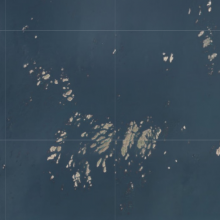
Horta
- Country:Norway
- Site number:2158
- Area:3,158 ha
- Designation date:27-05-2013
- Coordinates:65°12'N 11°25'E
Materials presented on this website, particularly maps and territorial information, are as-is and as-available based on available data and do not imply the expression of any opinion whatsoever on the part of the Secretariat of the Ramsar Convention concerning the legal status of any country, territory, city or area, or of its authorities, or concerning the delimitation of its frontiers or boundaries.
Overview
The Site is a small marine archipelago consisting of small islands, long fjords, skerries and islets. Its shallow marine waters with seaweed beds and kelp forests are rich in marine invertebrates and fish . The Site is an important breeding area for threatened birds such as the black guillemot Cepphus grylle and the Arctic tern Sterna paradisaea. It also hosts stable populations of Eurasian otter Lutra lutra, harbour seal Phoca vitulina, Atlantic puffin Fratercula arctica, and common murre Uria aalge. The false killer whale Pseudorca crassidens also occasionally visits the archipelago. The landscape is dominated by remnant infield areas, narrow mires, bogs, coastal heathlands, and islets with vegetation influenced by natural seabird fertilization. The vegetation has been shaped by many years of grazing and harvesting. A total of 171 different vascular plant species have been recorded. The Site is currently used by scientists for seabird monitoring and geological research, and by private landowners as a holiday site. The surrounding seas are used for fishing.
Administrative region:
Nord-Trøndelag
- National legal designation:
- Bird Protection Area - Horta
- Nature Reserve - Horta
- Last publication date:09-07-2018
Downloads
Ramsar Information Sheet (RIS)
Archived RIS
Site map
Additional reports and documents
- Site management plan
- Other published literature
